Research ArticleBrain
Open Access
Higher Rates of Decline for Women and Apolipoprotein E ε4 Carriers
D. Holland, R.S. Desikan, A.M. Dale and L.K. McEvoy for the Alzheimer's Disease Neuroimaging Initiative
American Journal of Neuroradiology December 2013, 34 (12) 2287-2293; DOI: https://doi.org/10.3174/ajnr.A3601
D. Holland
aFrom the Departments of Neurosciences (D.H., A.M.D., L.K.M.)
R.S. Desikan
bRadiology (R.S.D., A.M.D.), University of California, San Diego, La Jolla, California.
A.M. Dale
aFrom the Departments of Neurosciences (D.H., A.M.D., L.K.M.)
bRadiology (R.S.D., A.M.D.), University of California, San Diego, La Jolla, California.
L.K. McEvoy
aFrom the Departments of Neurosciences (D.H., A.M.D., L.K.M.)

REFERENCES
- 1.↵
- 2.↵
- Murray ME,
- Graff-Radford NR,
- Ross OA,
- et al
- 3.↵
- 4.↵
- van der Flier WM,
- Pijnenburg YA,
- Fox NC,
- et al
- 5.↵
Alzheimer's Association. 2013 Alzheimer's disease facts and figures. Alzheimers Dement 2013;9:208–45
- 6.↵
- Miech RA,
- Breitner JC,
- Zandi PP,
- et al
- 7.↵
- Farrer LA,
- Cupples LA,
- Haines JL,
- et al
- 8.↵
- Seshadri S,
- Wolf PA,
- Beiser A,
- et al
- 9.↵
- Andersen K,
- Launer LJ,
- Dewey ME,
- et al
- 10.↵
- 11.↵
- Breitner JC,
- Wyse BW,
- Anthony JC,
- et al
- 12.↵
- Barnes LL,
- Wilson RS,
- Schneider JA,
- et al
- 13.↵
- Hebert LE,
- Scherr PA,
- McCann JJ,
- et al
- 14.↵
- Ghebremedhin E,
- Schultz C,
- Thal DR,
- et al
- 15.↵
- 16.↵
- Corder EH,
- Saunders AM,
- Strittmatter WJ,
- et al
- 17.↵
- Verghese PB,
- Castellano JM,
- Holtzman DM
- 18.↵
- 19.↵
- Khachaturian AS,
- Corcoran CD,
- Mayer LS,
- et al
- 20.↵
- Corder EH,
- Saunders AM,
- Strittmatter WJ,
- et al
- 21.↵
- Holland D,
- McEvoy LK,
- Dale AM
- 22.↵
- Holland D,
- Dale AM
- 23.↵
- 24.↵
- Arriagada PV,
- Marzloff K,
- Hyman BT
- 25.↵
- Arnold SE,
- Hyman BT,
- Flory J,
- et al
- 26.↵
- Braak H,
- Braak E
- 27.↵
- 28.↵
- 29.↵
- Rosen WG,
- Mohs RC,
- Davis KL
- 30.↵
- 31.↵
- Folstein MF,
- Folstein SE,
- McHugh PR
- 32.↵
- Fitzmaurice GM,
- Laird NM,
- Ware JH
- 33.↵
- 34.↵
- Plassman BL,
- Langa KM,
- Fisher GG,
- et al
- 35.↵
- Corder EH,
- Ghebremedhin E,
- Taylor MG,
- et al
- 36.↵
- Yaffe K,
- Haan M,
- Byers A,
- et al
- 37.↵
- Xu H,
- Gouras GK,
- Greenfield JP,
- et al
- 38.↵
- Prince JA,
- Zetterberg H,
- Andreasen N,
- et al
- 39.↵
- Kester MI,
- Blankenstein MA,
- Bouwman FH,
- et al
- 40.↵
- 41.↵
- Koffie RM,
- Hashimoto T,
- Tai HC,
- et al
- 42.↵
- DeKosky ST,
- Scheff SW
- 43.↵
- Van Hoesen GW,
- Parvizi J,
- Chu CC
- 44.↵
- Saunders AM
- 45.↵
- Growdon JH,
- Locascio JJ,
- Corkin S,
- et al
- 46.↵
- Cosentino S,
- Scarmeas N,
- Helzner E,
- et al
- 47.↵
- Juva K,
- Verkkoniemi A,
- Viramo P,
- et al
- 48.↵
- Hyman BT
In this issue
American Journal of Neuroradiology
Vol. 34, Issue 12
1 Dec 2013
Advertisement
D. Holland, R.S. Desikan, A.M. Dale, L.K. McEvoy
Higher Rates of Decline for Women and Apolipoprotein E ε4 Carriers
American Journal of Neuroradiology Dec 2013, 34 (12) 2287-2293; DOI: 10.3174/ajnr.A3601
0 Responses
Jump to section
Related Articles
Cited By...
- Sex Differences in Cognitive Performance in Alzheimers Disease: Insights from the ADAS-Cog-13
- Kinematic Correlates of Early Speech Motor Changes in Cognitively Intact APOE-{varepsilon}4 Carriers: A Preliminary Study Using a Color-Word Interference Task
- Sex Differences in Vulnerability to Tau Pathology: Impact on Cognitive Decline
- APOE4 and Chronic Health Risk Factors are Associated with Sex-Specific Preclinical Alzheimers Disease Neuroimaging Biomarkers
- Sex differences in the clinical manifestation of autosomal dominant frontotemporal dementia
- Adolescent alcohol exposure alters age-related progression of behavioral and neurotrophic dysfunction in the TgF344-AD model in a sex-specific manner
- Age, Sex and Alzheimers disease: A longitudinal study of 3xTg-AD mice reveals sex-specific disease trajectories and inflammatory responses mirrored in postmortem brains from Alzheimers patients
- Differential neural circuit vulnerability to {beta}-amyloid and tau pathologies in novel Alzheimers disease mice
- Identification of Sex-Specific Genetic Variants Associated With Tau PET
- Subjective Cognitive Decline is a Better Marker for Future Cognitive Decline in Females than in Males
- Mendelian randomization confirms the role of Y-chromosome loss in Alzheimers Disease etiopathogenesis in males
- Investigating the temporal pattern of neuroimaging-based brain age estimation as a biomarker for Alzheimers Disease related neurodegeneration
- Age- and sex-dependent effects of DNA glycosylase Neil3 on amyloid pathology, adult neurogenesis, and memory in a mouse model of Alzheimers disease
- Sex influences the effects of APOE genotype and Alzheimers diagnosis on neuropathology and memory
- Sex-specific DNA methylation changes in Alzheimers disease pathology
- Apolipoprotein E genotype and MRI-detected brain alterations pertaining to neurodegeneration: A systematic review
- Dedifferentiation of memory-related brain function as a potential early biomarker of Alzheimers disease in asymptomatic older women: Results from the PREVENT-AD Cohort
- Sex-dependent effect of APOE on Alzheimer's disease and other age-related neurodegenerative disorders
- Inflammation in Alzheimers disease: do sex and APOE matter?
- Sex differences in cortisol and memory following acute social stress in amnestic mild cognitive impairment
- EFAD transgenic mice as a human APOE relevant preclinical model of Alzheimers disease
This article has not yet been cited by articles in journals that are participating in Crossref Cited-by Linking.
More in this TOC Section
Similar Articles
Advertisement











